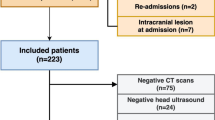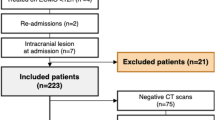Abstract
Objective:
To describe differences in characteristics among neonates treated with extracorporeal life support (ECLS) in the first week of life for respiratory failure compared with later in the neonatal period and to assess risk factors for central nervous system (CNS) hemorrhage and mortality among the two groups.
Study Design:
Review of the Extracorporeal Life Support Organization registry from 2001 to 2010 of neonates ⩽30 days comparing two age groups: those ⩽7 days (Group 1) to those >7 days (Group 2) at ECLS initiation.
Result:
Among 4888 neonates, Group 1 (n=4453) had significantly lower mortality (17 vs 39%, P<0.001) but greater CNS hemorrhage (11 vs 7%, P=0.02) than Group 2 (n=453). Mortality and CNS hemorrhage improved significantly with increasing gestational age only for Group 1 patients. CNS hemorrhage occurred more frequently in Group 1 patients receiving venoarterial (VA) than with venovenous ECLS (15 vs 7%, P<0.001). In Group 1, lower birth weight and pre-ECLS pH and VA mode were independently associated with mortality. In Group 2, higher mean airway pressure was independently associated with mortality. Complications of ECLS therapy, including CNS hemorrhage and renal replacement therapy were independently associated with mortality for both groups.
Conclusion:
Neonates cannulated for ECLS after the first week of life had greater mortality despite lower CNS hemorrhage than neonates receiving ECLS earlier. Premature infants cannulated after 1 week had fewer CNS hemorrhages than premature infants treated with extracorporeal membrane oxygenation starting within the first week of life.
This is a preview of subscription content, access via your institution
Access options
Subscribe to this journal
Receive 12 print issues and online access
$259.00 per year
only $21.58 per issue
Buy this article
- Purchase on Springer Link
- Instant access to full article PDF
Prices may be subject to local taxes which are calculated during checkout


Similar content being viewed by others
References
Bartlett RH, Gazzaniga AB, Jeffries MR, Huxtable RF, Haiduc NJ, Fong S . Extracorporeal membrane oxygenation (ECMO) cardiopulmonary support in infancy. Trans Am Soc Artif Intern Organs 1976; 22: 80–93.
Bartlett RH, Roloff DW, Cornell RG, Andrews AF, Dillon PW, Zwischenberger JB . Extracorporeal circulation in neonatal respiratory failure: a prospective randomized study. Pediatrics 1985; 76: 479–487.
O’Rouke PP, Crone RK, Vacanti JP, Ware JH, Lillehei CW, Parad RB et al. Extracorporeal membrane oxygenation and conventional medical therapy in neonates with persistent pulmonary hypertension of the newborn: a prospective randomized study. Pediatrics 1989; 84: 957–963.
UK Collaborative ECMO Trial Group. UK collaborative randomized trial of neonatal extracorporeal membrane oxygenation. Lancet 1996; 346: 75–82.
Mugford M, Elbourne D, Field D . Extracorporeal membrane oxygenation for severe respiratory failure in newborn infants. Cochrane Database Syst Rev 2008; 16 (3): CD 001340.
Hardart GE, Hardart MK, Arnold JH . Intracranial hemorrhage in premature neonates treated with extracorporeal membrane oxygenation correlates with conceptual age. J Pediatr 2004; 145: 184–189.
Ramachandrappa A, Rosenberg ES, Wagoner S, Jain L . Morbidity and mortality in late preterm infants with severe hypoxic respiratory failure on extracorporeal membrane oxygenation. J Pediatr 2011; 159: 192–198.
Lotze A, Mitchell BR, Bulas DI, Zola EM, Shalwitz RA, Gunkel JH . Multicenter study of surfactant (beractant) use in the treatment of term infants with severe respiratory failure. Survanta term infants study group. J Pediatr 1998; 132: 40–47.
Clark RH, Yoder BA, Sell MS . Prospective, randomized comparison of high-frequency oscillation and conventional ventilation in candidates for extracorporeal membrane oxygenation. J Pediatr 1994; 124: 447–454.
The Neonatal Inhaled Nitric Oxide Study Group. Inhaled nitric oxide in full-term and nearly full-term infants with hypoxic respiratory failure. N Engl J Med 1997; 336: 597–604.
Kinsella JP, Truog WE, Walsh WF, Goldberg RN, Bancalari E, Mayock DE et al. Randomized, multicenter trial of inhaled nitric oxide and high-frequency oscillatory ventilation in severe, persistent pulmonary hypertension of the newborn. J Pediatr 1997; 131: 55–62.
Gamsu HR, Mullinger BM, Donnai P, Dash CH . Antenatal administration of betamethasone to prevent respiratory distress syndrome in preterm infants: report of a UL multicenter trial. Br J Obstet Gynacecol 1989; 96: 401–410.
Hintz SR, Suttner DM, Sheehan AM, Rhine WD, Van Meurs KP . Decreased use of neonatal extracorporeal membrane oxygenation (ECMO): how new treatment modalities have affected ECMO utilization. Pediatrics 2000; 106: 1339–1343.
ECMO Registry of the Extracorporeal Life Support Organization (ELSO). Ann Arbor. Michigan, January 2013.
Roy BJ, Rycus P, Conrad SA, Clark RH . The changing demographics of neonatal extracorporeal membrane oxygenation patients reported to the Extracorporeal Life Support Organization (ELSO) registry. Pediatrics 2000; 106: 1334–1338.
Kugleman A, Ganqitano E, Taschuk R, Garza R, Riskin A, McEvoy C et al. Extracorporeal membrane oxygenation in infants with meconium aspiration syndrome: a decade experience with venovenous ECMO. J Pediatr Surg 2005; 40: 1082–1089.
Masiakos PT, Islam S, Doody DP, Schnitzer JJ, Ryan DP . Extracorporeal membrane oxygenation for nonneonatal acute respiratory failure. Arch Surg 1999; 134: 375–379.
Skinner SC, Iocono JA, Ballard HO, Turner MD, Ward AN, Davenport DL et al. Improved survival in venovenous vs venoarterial extracorporeal membrane oxygenation for pediatric noncardiac sepsis patients: a study of the Extracorporeal Life Support Organization registry. J Pediatr Surg 2012; 47: 63–67.
Roberts N, Westrope C, Pooboni SK, Mulla H, Peek GJ, Sosnowski AW et al. Venovenous extracorporeal membrane oxygenation for respiratory failure in inotrope dependent neonates. ASAIO J 2003; 49: 568–571.
Kim K, Mazor RL, Rycus PT, Brogan TV . Use of veno-venous ECLS in pediatric patients for cardiac indications: a review of the ELSO registry. Pediatr Crit Care Med 2012; 13: 285–289.
Rollins MD, Yoder MA, Moore KR, Barnhart DC, Jones C, Null DM et al. Utility of neuroradiographic imaging in predicting outcomes after neonatal extracorporeal membrane oxygenation. J Pediatr Surg 2012; 47: 76–80.
Cengiz P, Seidel K, Rycus P, Brogan TV, Roberts JS . Central nervous system complications during pediatric extracorporeal life support: incidence and risk factors. Crit Care Med 2005; 33: 2817–2824.
Hardart GE, Fackler JC . Predictors of intracranial hemorrhage during neonatal extracorporeal membrane oxygenation. J Pediatr 1999; 134: 156–159.
Green TP, Moler FW, Goodman DM . Probability of survival after prolonged extracorporeal membrane oxygenation in pediatric patients with acute respiratory failure. Extracorporeal Life Support Organization. Crit Care Med 1995; 23: 1132–1139.
Madderom MJ, Gischler SJ, Duivenvoorden H, Tibboel D, Ijsseltijn H . Neonatal extracorporeal oxygenation: impaired health at 5 years of age. Pediatr Crit Care Med 2013; 14: 183–193.
McNally H, Bennett CC, Elbourne D, Field DJ . United Kingdom collaborative randomized trial of neonatal extracorporeal membrane oxygenation: follow-up to age 7 years. Pediatrics 2006; 117: e845–e854.
Acknowledgements
The authors wish to thank Dr Natalie Rintoul for her helpful comments on study design and Dr Ravi Thiagarajan for his suggestions regarding statistical analysis.
Author information
Authors and Affiliations
Corresponding author
Ethics declarations
Competing interests
The authors declare no conflict of interest
Rights and permissions
About this article
Cite this article
Smith, K., McMullan, D., Bratton, S. et al. Is age at initiation of extracorporeal life support associated with mortality and intraventricular hemorrhage in neonates with respiratory failure?. J Perinatol 34, 386–391 (2014). https://doi.org/10.1038/jp.2013.156
Received:
Revised:
Accepted:
Published:
Issue Date:
DOI: https://doi.org/10.1038/jp.2013.156
Keywords
This article is cited by
-
Extrakorporale Membranoxygenierung und „extracorporeal life support“ im Kindesalter und bei angeborenen Herzfehlern
Zeitschrift für Herz-,Thorax- und Gefäßchirurgie (2021)



